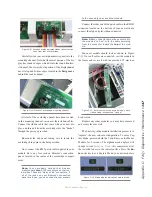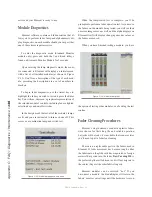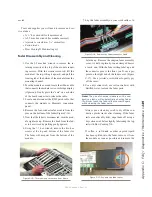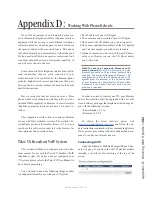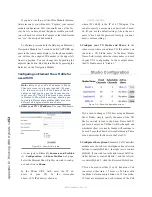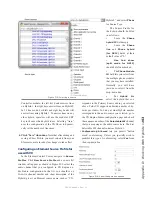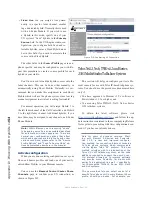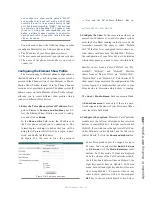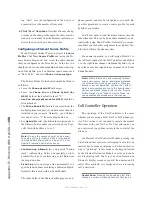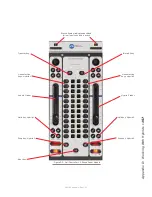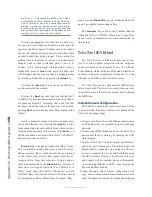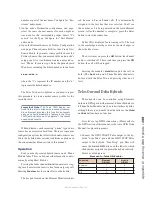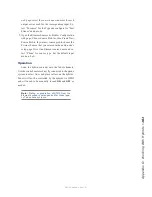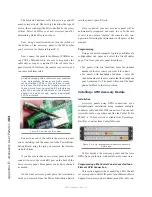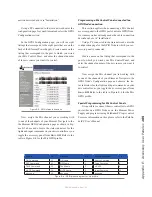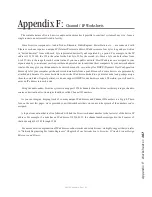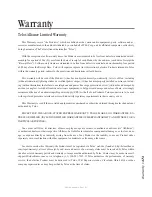
A
pp
en
di
x D
: W
or
ki
ng W
ith H
yb
ri
ds •
16
0
©2016 Axia Audio- Rev 1.8.1
Element-to-Telos Delta cable:
Function
Element
DB-15M
Hybrid
DB-15M
Common
7
6
On
4
1
Off
5
7
2. Connect the hybrid inputs and outputs to an Audio
node.
3. Using the Node’s Source configuration web page, en-
ter a text name and channel number for each input. It
might be convenient to include the telephone number
as part of the text name. Configure for “Fast Stream”
audio mode.
4. Using the Node’s Destination configuration web
page, select the same channel number for each out-
put as was used for the corresponding input. Select
“To source” for the Type. This is how Element’s au-
tomatic backfeed/mix-minus knows where the back-
feed should be sent. Configure for “Fast Stream” au-
dio mode.
5. Open the Element Sources & Profiles Configuration
web page. Choose Source Profiles, then Create New
Source Profile. In your new source profile, choose the
Primary Source that you entered in the audio node’s
setup page. Give it an Element source name and se-
lect “Phone” for source type. Select a Hybrid Answer
Mode of “Channel ON answers hybrid” or “Channel
ON or Preview ON answers hybrid”.
6. Open Element’s Module Manager/GPIO Configura-
tion web page. You will see the following:
Figure D-8: GPIO setup
For the physical GPIO you will be connecting to
the hybrid, enter or select from the drop-down box
the Livewire source channel for the hybrid. Note the
Livewire channel number and name are keys to the
GPIO as well as to audio signals. Element will generate
the appropriate control signals for hybrids when Phone is
selected as the source type.
The status display above the entry boxes show you
the GPIO status and are useful for troubleshooting.
Operation
Load the hybrid source onto a fader channel. If you
are using the GPIO to control the Hybrid functions for
the Telos One or Delta hybrids, pressing the fader chan-
nel
ON
button turns the Hybrid ON, and pressing the
Off
button turns the Hybrid OFF.
Note: Dialing or generation of DTMF from the
Element keypad is not supported for the Telos
ONE.
Telos ONE-x-Six, Direct Interface and 1A2 Sys-
tems
To use these legacy hybrids, audio must be connected
via Analog nodes. There is a special two-position control
panel that can drop into Element to control ONE-x-Six,
Direct Interface Module or 1A2 phone systems. This
panel communicates directly to the phone systems us-
ing a dedicated cable rather than via Ethernet. Line Take
and Drop functions cannot be controlled using GPIO on
these systems, so the control surfaces supplied with the
phone systems must be used to actuate these commands.
Installation & Configuration
1. Install the control module and connect it to the phone
equipment.
2. Connect audio input, output, and Program-On-Hold
to an Analog node. Use the left channel inputs and
outputs for these mono signals.
3. Using the Analog node’s Source configuration web
page, enter a text name and channel number for each
input. It might be convenient to include the telephone
number as part of the text name. Configure for “Fast
Stream” audio mode.
4. Using the audio node’s Destination configuration
Содержание element v.2.0
Страница 100: ...5 Element Operations 90 2016 Axia Audio Rev 1 8 1 Capital budget may you never decrease for we need new test gear...
Страница 149: ...Appendix A Specifications 139 2016 Axia Audio Rev 1 8 1...
Страница 183: ...Warranty 173 2016 Axia Audio Rev 1 8 1 TCP IP How did we live without thee Analogicly...
Страница 184: ...THIS PAGE INTENTIONALLY LEFT BLANK...
Страница 185: ...THIS PAGE INTENTIONALLY LEFT BLANK...


